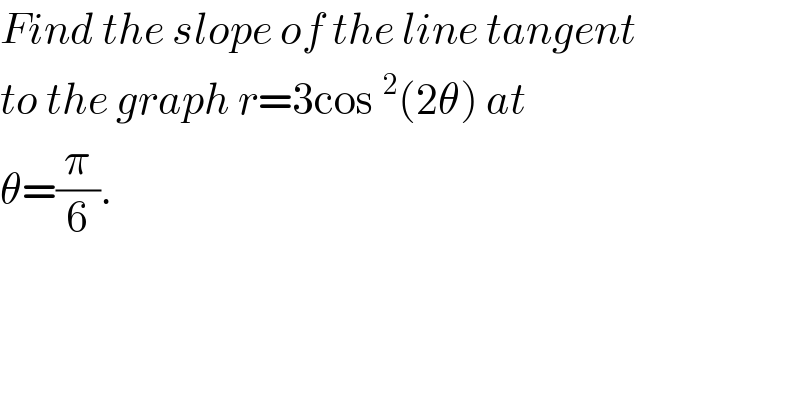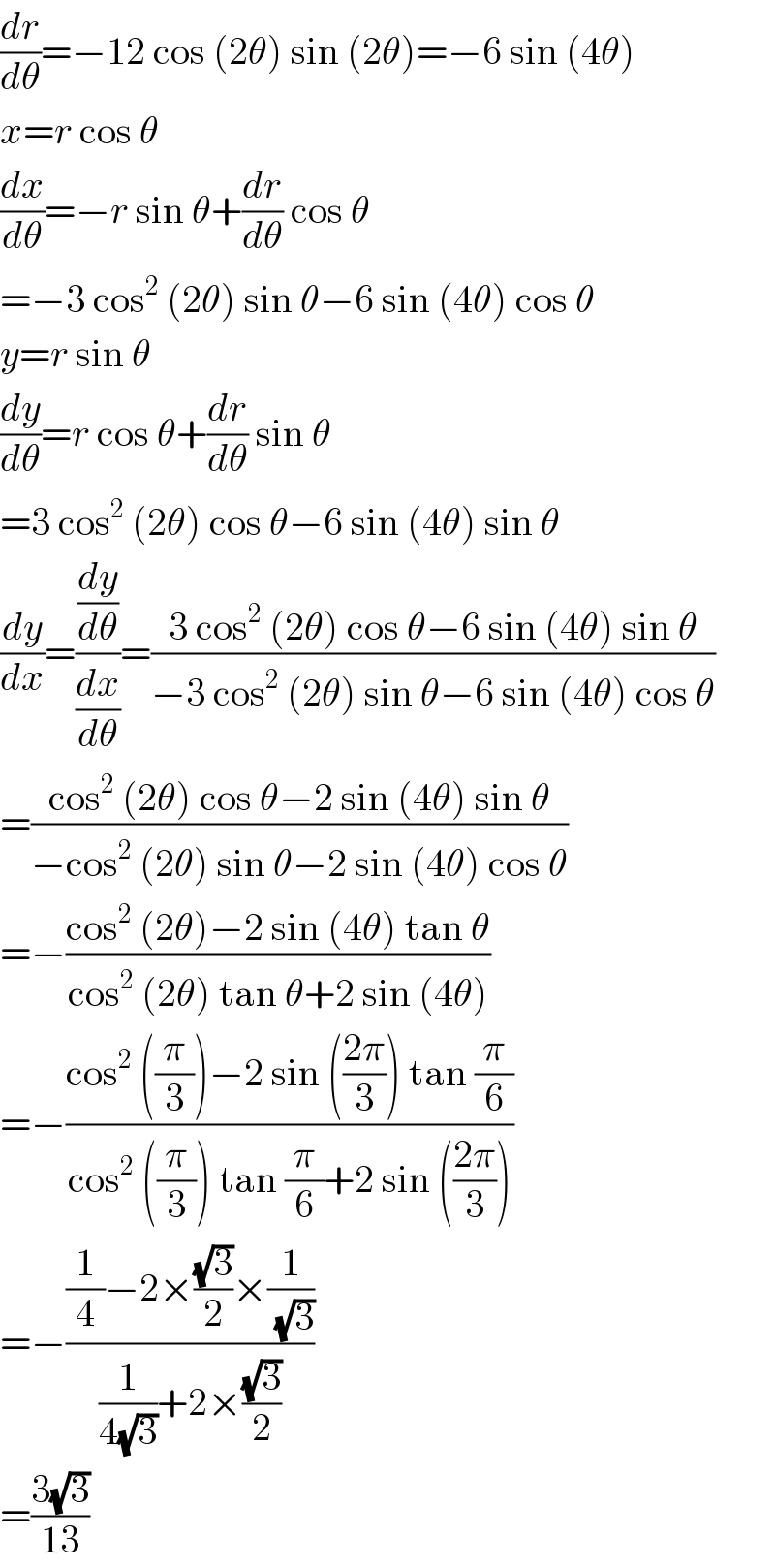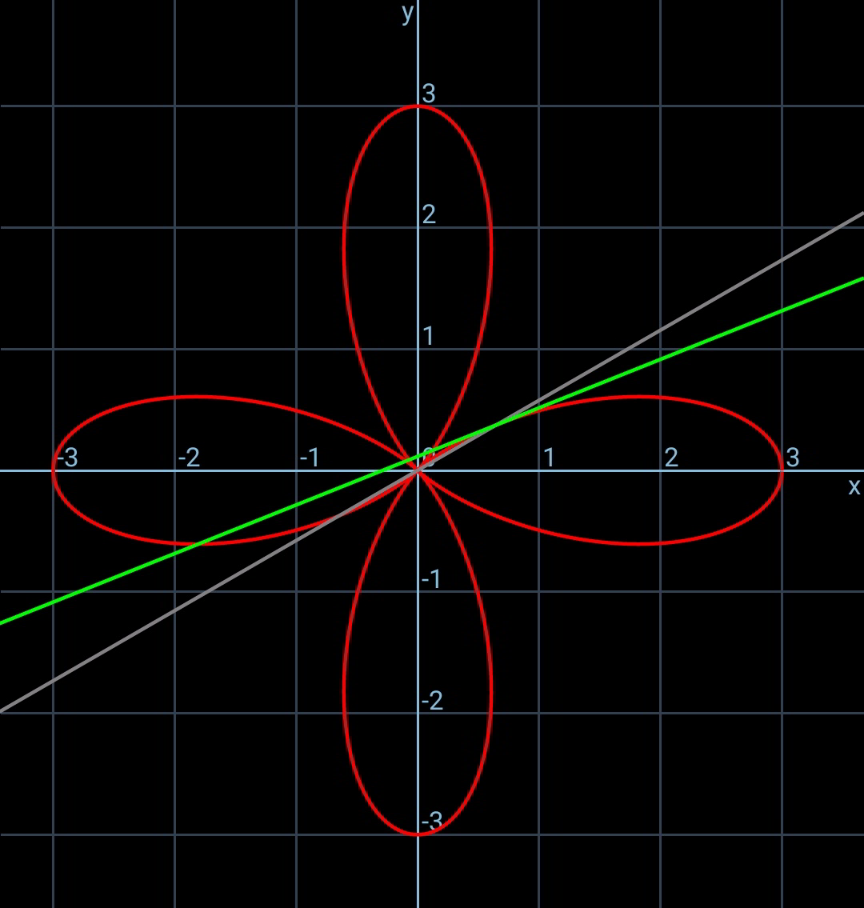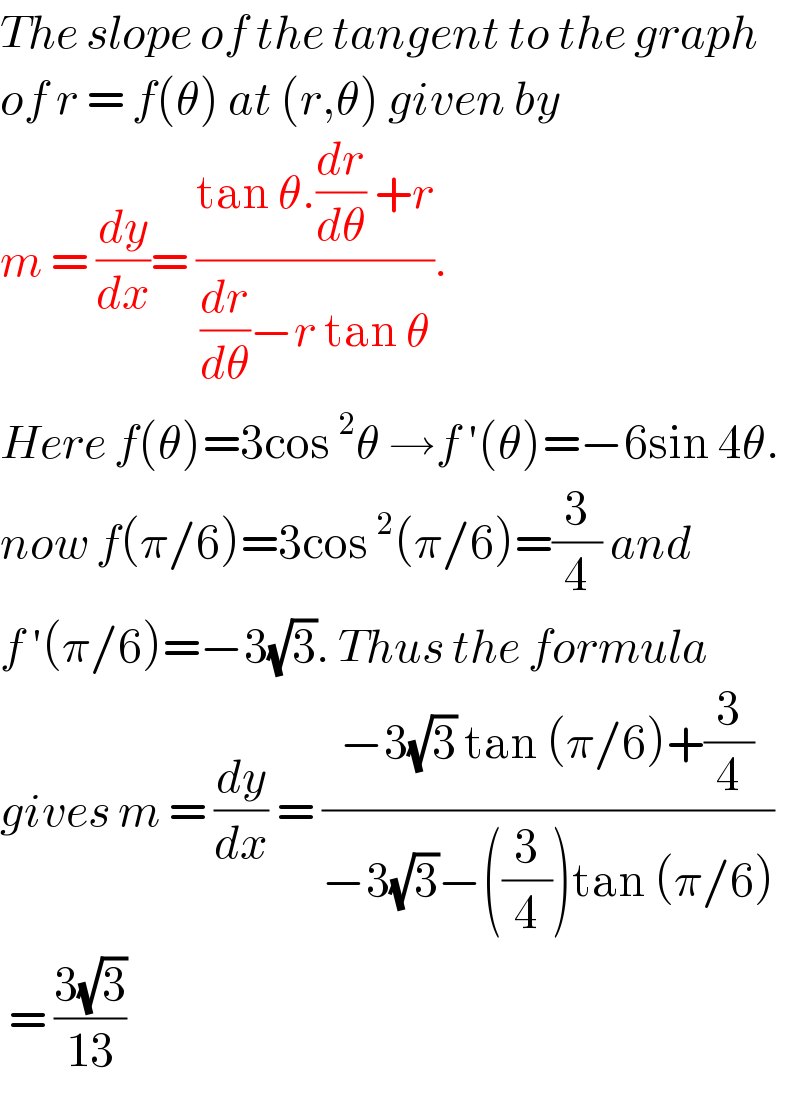
Question Number 120463 by bramlexs22 last updated on 31/Oct/20

$${Find}\:{the}\:{slope}\:{of}\:{the}\:{line}\:{tangent} \\ $$$${to}\:{the}\:{graph}\:{r}=\mathrm{3cos}\:^{\mathrm{2}} \left(\mathrm{2}\theta\right)\:{at} \\ $$$$\theta=\frac{\pi}{\mathrm{6}}.\: \\ $$
Answered by mr W last updated on 31/Oct/20

$$\frac{{dr}}{{d}\theta}=−\mathrm{12}\:\mathrm{cos}\:\left(\mathrm{2}\theta\right)\:\mathrm{sin}\:\left(\mathrm{2}\theta\right)=−\mathrm{6}\:\mathrm{sin}\:\left(\mathrm{4}\theta\right) \\ $$$${x}={r}\:\mathrm{cos}\:\theta \\ $$$$\frac{{dx}}{{d}\theta}=−{r}\:\mathrm{sin}\:\theta+\frac{{dr}}{{d}\theta}\:\mathrm{cos}\:\theta \\ $$$$=−\mathrm{3}\:\mathrm{cos}^{\mathrm{2}} \:\left(\mathrm{2}\theta\right)\:\mathrm{sin}\:\theta−\mathrm{6}\:\mathrm{sin}\:\left(\mathrm{4}\theta\right)\:\mathrm{cos}\:\theta \\ $$$${y}={r}\:\mathrm{sin}\:\theta \\ $$$$\frac{{dy}}{{d}\theta}={r}\:\mathrm{cos}\:\theta+\frac{{dr}}{{d}\theta}\:\mathrm{sin}\:\theta \\ $$$$=\mathrm{3}\:\mathrm{cos}^{\mathrm{2}} \:\left(\mathrm{2}\theta\right)\:\mathrm{cos}\:\theta−\mathrm{6}\:\mathrm{sin}\:\left(\mathrm{4}\theta\right)\:\mathrm{sin}\:\theta \\ $$$$\frac{{dy}}{{dx}}=\frac{\frac{{dy}}{{d}\theta}}{\frac{{dx}}{{d}\theta}}=\frac{\mathrm{3}\:\mathrm{cos}^{\mathrm{2}} \:\left(\mathrm{2}\theta\right)\:\mathrm{cos}\:\theta−\mathrm{6}\:\mathrm{sin}\:\left(\mathrm{4}\theta\right)\:\mathrm{sin}\:\theta}{−\mathrm{3}\:\mathrm{cos}^{\mathrm{2}} \:\left(\mathrm{2}\theta\right)\:\mathrm{sin}\:\theta−\mathrm{6}\:\mathrm{sin}\:\left(\mathrm{4}\theta\right)\:\mathrm{cos}\:\theta} \\ $$$$=\frac{\mathrm{cos}^{\mathrm{2}} \:\left(\mathrm{2}\theta\right)\:\mathrm{cos}\:\theta−\mathrm{2}\:\mathrm{sin}\:\left(\mathrm{4}\theta\right)\:\mathrm{sin}\:\theta}{−\mathrm{cos}^{\mathrm{2}} \:\left(\mathrm{2}\theta\right)\:\mathrm{sin}\:\theta−\mathrm{2}\:\mathrm{sin}\:\left(\mathrm{4}\theta\right)\:\mathrm{cos}\:\theta} \\ $$$$=−\frac{\mathrm{cos}^{\mathrm{2}} \:\left(\mathrm{2}\theta\right)−\mathrm{2}\:\mathrm{sin}\:\left(\mathrm{4}\theta\right)\:\mathrm{tan}\:\theta}{\mathrm{cos}^{\mathrm{2}} \:\left(\mathrm{2}\theta\right)\:\mathrm{tan}\:\theta+\mathrm{2}\:\mathrm{sin}\:\left(\mathrm{4}\theta\right)} \\ $$$$=−\frac{\mathrm{cos}^{\mathrm{2}} \:\left(\frac{\pi}{\mathrm{3}}\right)−\mathrm{2}\:\mathrm{sin}\:\left(\frac{\mathrm{2}\pi}{\mathrm{3}}\right)\:\mathrm{tan}\:\frac{\pi}{\mathrm{6}}}{\mathrm{cos}^{\mathrm{2}} \:\left(\frac{\pi}{\mathrm{3}}\right)\:\mathrm{tan}\:\frac{\pi}{\mathrm{6}}+\mathrm{2}\:\mathrm{sin}\:\left(\frac{\mathrm{2}\pi}{\mathrm{3}}\right)} \\ $$$$=−\frac{\frac{\mathrm{1}}{\mathrm{4}}−\mathrm{2}×\frac{\sqrt{\mathrm{3}}}{\mathrm{2}}×\frac{\mathrm{1}}{\:\sqrt{\mathrm{3}}}}{\frac{\mathrm{1}}{\mathrm{4}\sqrt{\mathrm{3}}}+\mathrm{2}×\frac{\sqrt{\mathrm{3}}}{\mathrm{2}}} \\ $$$$=\frac{\mathrm{3}\sqrt{\mathrm{3}}}{\mathrm{13}} \\ $$
Commented by mr W last updated on 31/Oct/20

Answered by john santu last updated on 01/Nov/20

$${The}\:{slope}\:{of}\:{the}\:{tangent}\:{to}\:{the}\:{graph} \\ $$$${of}\:{r}\:=\:{f}\left(\theta\right)\:{at}\:\left({r},\theta\right)\:{given}\:{by}\: \\ $$$${m}\:=\:\frac{{dy}}{{dx}}=\:\frac{\mathrm{tan}\:\theta.\frac{{dr}}{{d}\theta}\:+{r}}{\frac{{dr}}{{d}\theta}−{r}\:\mathrm{tan}\:\theta}. \\ $$$${Here}\:{f}\left(\theta\right)=\mathrm{3cos}\:^{\mathrm{2}} \theta\:\rightarrow{f}\:'\left(\theta\right)=−\mathrm{6sin}\:\mathrm{4}\theta. \\ $$$${now}\:{f}\left(\pi/\mathrm{6}\right)=\mathrm{3cos}\:^{\mathrm{2}} \left(\pi/\mathrm{6}\right)=\frac{\mathrm{3}}{\mathrm{4}}\:{and}\: \\ $$$${f}\:'\left(\pi/\mathrm{6}\right)=−\mathrm{3}\sqrt{\mathrm{3}}.\:{Thus}\:{the}\:{formula} \\ $$$${gives}\:{m}\:=\:\frac{{dy}}{{dx}}\:=\:\frac{−\mathrm{3}\sqrt{\mathrm{3}}\:\mathrm{tan}\:\left(\pi/\mathrm{6}\right)+\frac{\mathrm{3}}{\mathrm{4}}}{−\mathrm{3}\sqrt{\mathrm{3}}−\left(\frac{\mathrm{3}}{\mathrm{4}}\right)\mathrm{tan}\:\left(\pi/\mathrm{6}\right)} \\ $$$$\:=\:\frac{\mathrm{3}\sqrt{\mathrm{3}}}{\mathrm{13}} \\ $$
